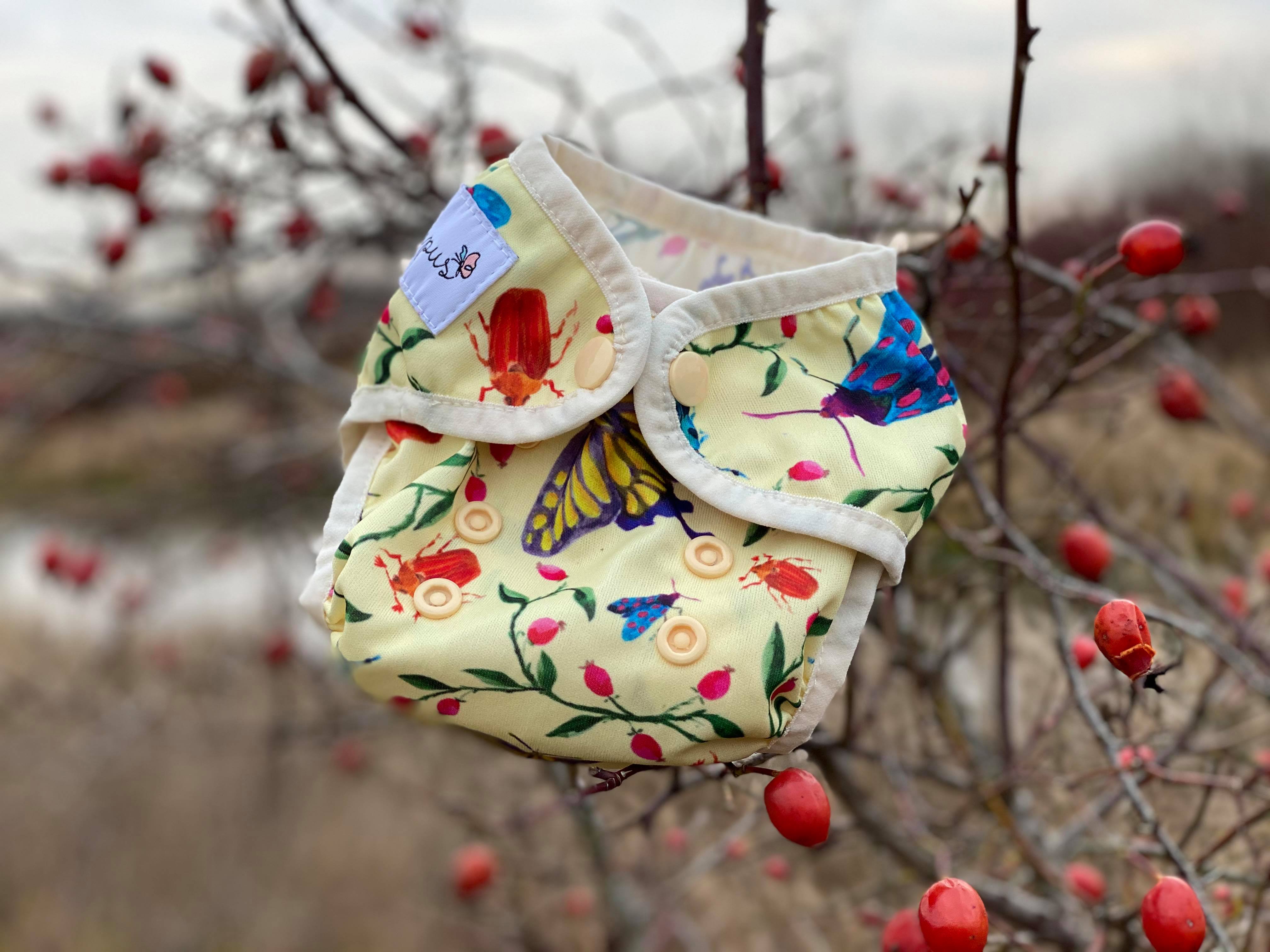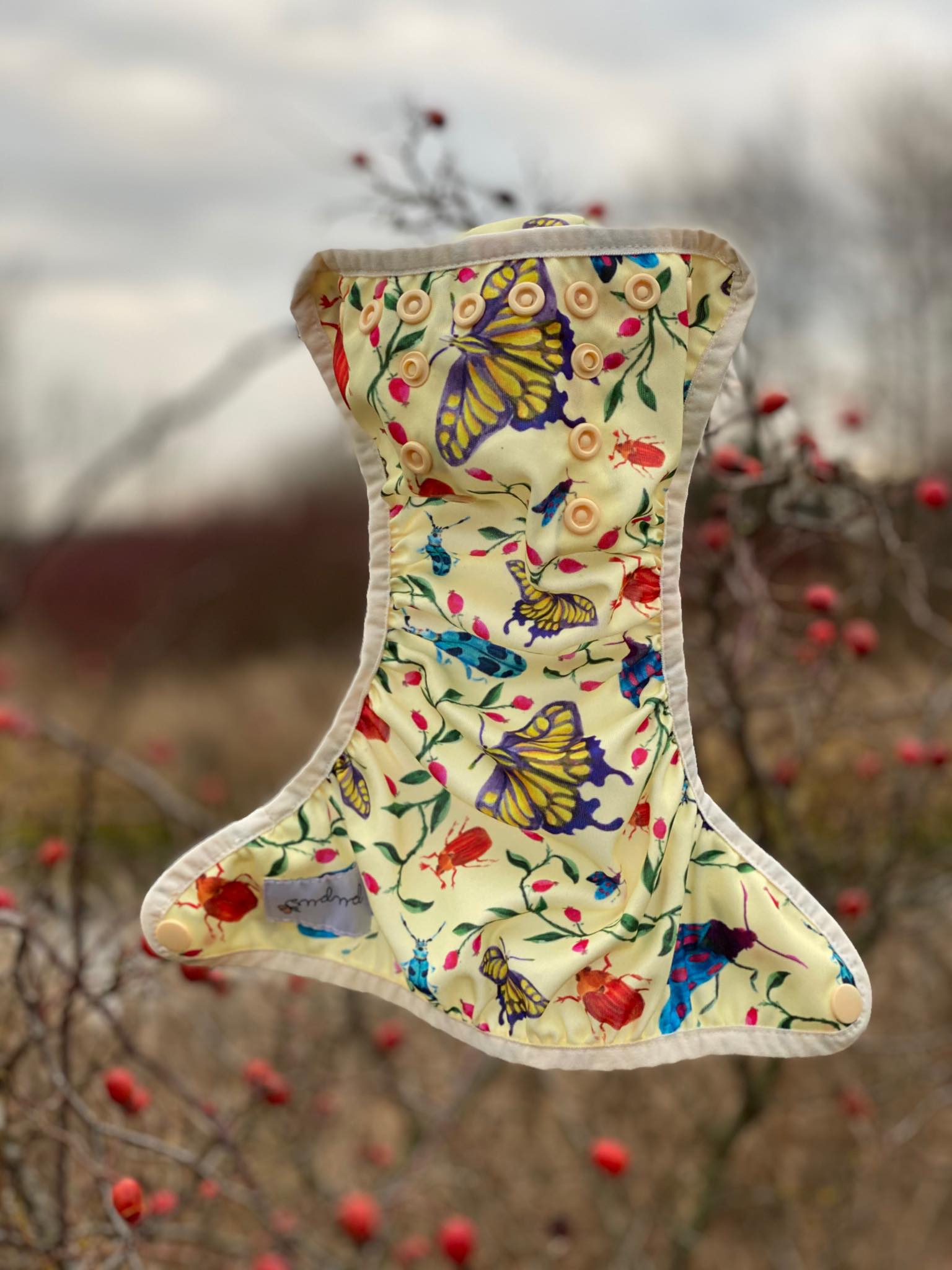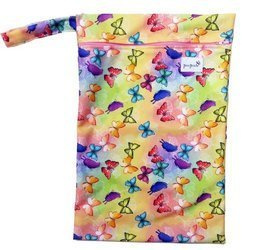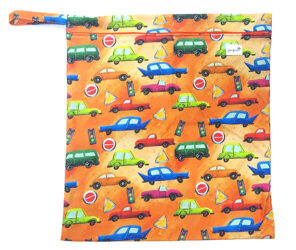How to wash reusable diapers?

Washing cloth diapers is often the thing our grandparents and parents use to scare us. It's true, our parents washed muslin in semi-automatic machines, used soap flakes, and disposable diapers were only available in foreign currency stores. People who are critical of using cloth diapers may perceive washing dirty diapers as a chore, hard work, or at least as chaotic as shown below :)
Nowadays, a cloth diaper bears no resemblance to rough muslin in a oilcloth cover – it is an eco-friendly, breathable, and easy-to-use product. Each soiled diaper (except wool) is placed in a bucket or a PUL wet bag, to which we can add tea tree or lavender oil (to inhibit bacterial growth). Then, every 1–3 days, we transfer the entire contents of the bucket to the washing machine, add the recommended amount of detergent and, if needed, disinfectant, hang the diapers overnight to dry, and they are usually ready for use by morning. In reality, diaper washing is simple and organized. More or less like this.
Simple? Yes, it really is simple – it only requires consistency and a small amount of work. However, to ensure cloth diapers do not become a burden, which opponents of our idea might secretly enjoy, we need to know how to properly organize all stages of using cloth diapers. Skills and accessories for cloth diapering are crucial here. I will try to present them as concisely as possible.
1. Bucket, diaper bag, and essential oils
The type of bucket we choose depends solely on our needs and preferences. It is important that it has a lid and can hold at least two days’ worth of used diapers. After trying several types of buckets, we decided on a rectangular, very spacious bucket, which can also serve as a step stool by the sink. It has served a dual purpose in our bathroom for years – as a container for soiled diapers and as a stool for our children. Used diapers stored in a closed bucket can smell unpleasant and promote bacterial growth.
You can also use only a PUL diaper bag
- PUL bags are breathable, waterproof, and do not allow odors to escape.
- A 50 × 55 cm bag easily holds two days’ worth of diapers. It closes with a drawstring (two stoppers).
- For outings, a medium 42 × 30 cm bag with a convenient zipper is essential. It holds about 6 diapers with inserts.
- A small bag 15 × 18 cm fits only one diaper.
- Storing diapers in single-use plastic bags or trash bags is not recommended, as bacteria multiply faster in a tightly sealed bag and it produces unnecessary waste.
To neutralize the smell of dirty diapers, we use essential oils.
The strongest antibacterial and antifungal effects come from tea tree oil and lavender oil. That’s why we use them most often. It is recommended to add a few drops to the bottom of the bucket or PUL bag, and a few more at the end of the first day of filling to mask the odor of diapers waiting to be washed. Keep in mind that essential oils mainly act locally, so a few drops in the bucket or wash won’t completely sanitize dry-stored diapers but will make them smell more pleasant.
2. Pre-rinsing diapers
Oh no, poop, what bad luck… Unfortunately, with cloth diapers, unlike disposables, you have to do something about it.We should not put a heavily soiled diaper directly into the bucket or, especially, the washing machine. How to handle a soiled diaper?
- If the diaper is only wet or soiled with milk stool, place it along with its contents in the bucket or PUL bag, where it will wait for a maximum of 2–3 days. Milk stool dissolves perfectly during washing, so rinsing is unnecessary unless you want to. As long as the child is not eating solid foods, the process is simple – roughly until 6 months old.
- If the diaper contains feces from a child eating solids, shake the stool into the toilet, or if using liners, discard the liner with the contents, and rinse the diaper under cold, strong running water to remove solids.
- Remember that warm water sets stains, so rinse in cold water. To ensure a stain comes out, rub it with gall soap, let it sit briefly, and rinse. A soapberry stain remover spray is also effective and suitable for wool.
- If there’s no bidet or a small bathroom, a sink faucet with a bidetta (small hand shower) is very useful. It allows quick rinsing of diaper contents into the toilet without dirtying the bathroom.
3. Rinse!
Before the main wash, remember to run 1 or 2 rinses or a pre-wash. You can add a small amount of detergent to roughly clean the diapers. This is necessary, otherwise the diapers would wash in “pee soup”… :/
4. Diaper detergent
The biggest problem from improper washing is the risk of greasing microfiber, Coolmax, and other synthetic inserts. This is a main cause of leaks because greased materials repel moisture, causing urine to run off like water on a duck and leak outside the diaper. Therefore, avoid fabric softeners, soap nuts, and detergents containing more than 5% soap.
Suitable detergents include white laundry powders (Jelp, Biały Jeleń, Ariel, Bryza, Vizir, Formil). Bobini and Lovela foam a lot but can also be used. My favorite is the eco-friendly BioD or Miocare powder – easy to rinse, biodegradable, safe for aquatic life, and cleans stains effectively.
Why white powder? Only white powders contain oxygen bleach, which effectively removes stains. No liquid detergent or color powder has this, so we use it only when white powder runs out. Liquid detergents can lead to poor stain removal, residue in diapers, unpleasant odor, and require stripping.
If PUL diapers are factory-coated, watch the oxygen bleach content – it should not exceed 15%. A safe range for the coating is 5–15% oxygen bleach. For example, Domol from Rossmann has >15%, better for uncoated diapers. Be careful with disinfectants too, frequent use can remove the PUL coating.
How to check if a PUL diaper is factory-coated? Sprinkle water on the colored outside – if it beads, the PUL is coated and should be protected. Even if the coating fades, the diaper remains functional, like Smart Bottoms, which have a laminated waterproof layer inside.
According to latest recommendations, use the amount of detergent indicated by the manufacturer. Adjust soil level to water hardness. Treat diapers as heavily soiled laundry, as water is generally hard or medium hard. Test water hardness quickly or check local waterworks website. Set pre-wash or rinse and cotton program at 60°C or 40°C with disinfectant such as Nappy Fresh, Miofresh or Igienizzante Bucato. For best effect, alternate disinfectant brands (finish one NF pack, switch to another). You can also add a few drops of essential oil to the final rinse for a pleasant scent.
If stains remain after washing, add a small amount of BioD stain remover to detergent and disinfectant. You can also sun-dry wet, washed diapers to bleach stains, or apply a paste of water and sodium percarbonate. Do not overload the washing machine – fill up to 2/3 max.
5. Washing and drying
*worst way to hang diapers – vertical stretching damages elastics, rose spikes can harm laminate
PUL diapers are washed in the washing machine with pre-wash/rinse on cotton program at 60°C or 40°C with disinfectant and extra rinse. Use white detergent containing <5% soap and 5–15% oxygen bleach. Set spin speed according to label, usually 800–1000 rpm, higher may loosen elastics.
Before washing, remove inserts, unfasten SIO inserts, and secure Velcro. Velcro may weaken or damage inserts in the wash. Fasten Velcro to inner wings before placing in bucket.
Do not undo waist snaps for washing – saves elastic, interior may not clean fully, especially AIO. Length-adjusting snaps can remain fastened until child outgrows.
Wash diapers with clothes and towels (after pre-rinse – alone first). Avoid drying PUL directly on radiators or in frost – extreme heat or cold can damage PUL. Can lay towel on radiator and hang diapers, or place AIO on moderately warm radiator, avoiding contact. Drying outdoors is best for speed and sun bleaching stains.
Hang all elastic items (covers, pocket diapers, AIO, fitteds) in ways that do not stretch elastics. Can hang sideways, flat, or drape over two lines – prolongs elastic life.
All inserts, fitteds, and some AIO can go in tumble dryer, following manufacturer’s program. Polish manufacturers often advise against AIO tumble drying, possibly due to different PUL lamination. I sometimes tumble dry AIO on gentle program at own risk – they hold up well. If a diaper is damaged in dryer, no claim – manufacturer instructions not followed.
Diapers from dryer are very soft – nothing softens muslin like a dryer. Without one, soften inserts or muslin by:
· Pulling over table edge or kneading
· “Acidifying” – soak in hot water with citric acid a few hours, spin, then 2–3 washes without detergent (not PUL, wool, fitteds). Softness lasts a few washes.
· Add Ecozone softener to rinse for cloth diapers (except PUL/wool) or soak overnight – fitteds too. Softness lasts only until next wash, like kneading/pulling.
Washing cloth diapers is not overly complicated or burdensome. Choosing cloth diapers simply adds about three extra loads per week. Is there anything that makes diaper washing easier for you? Do you have tried-and-true stain removal methods? We would love to hear about them.
Recommended

Diaper bag BUTTERFLIES, 42x30cm

